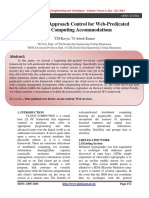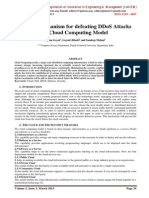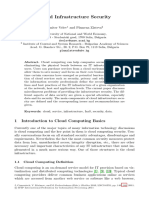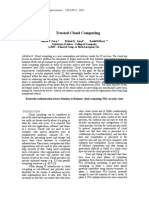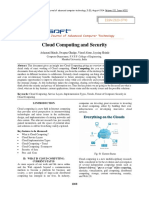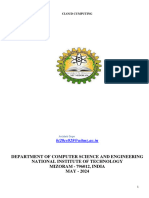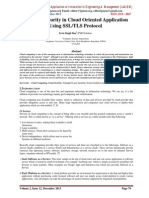0 ratings0% found this document useful (0 votes)
26 viewsFin Irjmets1656767576
Fin Irjmets1656767576
Uploaded by
Sowmya MThis document summarizes a research paper that proposes a new dual access control method for cloud-based data storage. The proposed method uses a progressive architecture and clock to provide fine-grained access control. It allows users to easily transmit, download, and delete documents from the cloud in a secure manner. The method aims to address security issues with existing cloud access control techniques by being more adaptable and efficient. It involves users and data owners registering for the cloud. When a client requests access to an owner's data, the owner checks the client's attributes and sends an encrypted key to the client that is only valid for a limited time period set by the clock.
Copyright:
© All Rights Reserved
Available Formats
Download as PDF, TXT or read online from Scribd
Fin Irjmets1656767576
Fin Irjmets1656767576
Uploaded by
Sowmya M0 ratings0% found this document useful (0 votes)
26 views4 pagesThis document summarizes a research paper that proposes a new dual access control method for cloud-based data storage. The proposed method uses a progressive architecture and clock to provide fine-grained access control. It allows users to easily transmit, download, and delete documents from the cloud in a secure manner. The method aims to address security issues with existing cloud access control techniques by being more adaptable and efficient. It involves users and data owners registering for the cloud. When a client requests access to an owner's data, the owner checks the client's attributes and sends an encrypted key to the client that is only valid for a limited time period set by the clock.
Original Description:
.
Original Title
fin_irjmets1656767576
Copyright
© © All Rights Reserved
Available Formats
PDF, TXT or read online from Scribd
Share this document
Did you find this document useful?
Is this content inappropriate?
This document summarizes a research paper that proposes a new dual access control method for cloud-based data storage. The proposed method uses a progressive architecture and clock to provide fine-grained access control. It allows users to easily transmit, download, and delete documents from the cloud in a secure manner. The method aims to address security issues with existing cloud access control techniques by being more adaptable and efficient. It involves users and data owners registering for the cloud. When a client requests access to an owner's data, the owner checks the client's attributes and sends an encrypted key to the client that is only valid for a limited time period set by the clock.
Copyright:
© All Rights Reserved
Available Formats
Download as PDF, TXT or read online from Scribd
Download as pdf or txt
0 ratings0% found this document useful (0 votes)
26 views4 pagesFin Irjmets1656767576
Fin Irjmets1656767576
Uploaded by
Sowmya MThis document summarizes a research paper that proposes a new dual access control method for cloud-based data storage. The proposed method uses a progressive architecture and clock to provide fine-grained access control. It allows users to easily transmit, download, and delete documents from the cloud in a secure manner. The method aims to address security issues with existing cloud access control techniques by being more adaptable and efficient. It involves users and data owners registering for the cloud. When a client requests access to an owner's data, the owner checks the client's attributes and sends an encrypted key to the client that is only valid for a limited time period set by the clock.
Copyright:
© All Rights Reserved
Available Formats
Download as PDF, TXT or read online from Scribd
Download as pdf or txt
You are on page 1of 4
e-ISSN: 2582-5208
International Research Journal of Modernization in Engineering Technology and Science
( Peer-Reviewed, Open Access, Fully Refereed International Journal )
Volume:04/Issue:06/June-2022 Impact Factor- 6.752 www.irjmets.com
DUAL ACCESS CONTROL FOR CLOUD BASED DATA STORAGE
Shwetha Shree K*1, Mohan Kumar*2
*1Master Of Computer Application, East West Institute Of
Technology(VTU), Bangalore, India.
ABSTRACT
Distributed computing is a high-level breakthrough in the making. Information storage is a huge headache for
everyone in this world. Distributed computing is an excellent solution for storing and retrieving data in the
most straightforward and quickest way possible. Security is the most pressing concern in distributed
computing. I'm attempting to show another approach for giving distributed computing had admission control
in this paper. In distributed computing, this architecture provides secured admittance control. It adopts a
progressive construction and use a clock to provide more granular access control. We can easily transmit,
download, and delete documents from and to the cloud using this method. Access Control, Cloud Computing,
and Cloud Privacy are some of the terms on the list. the National Institute of Standards and Technology [3]
states that. This decentralised computing has numerous advantages, especially in ubiquitous administrations
where everyone can access PC administrations over the internet. You may create a device with a small display,
processor, and RAM using distributed computing. Different types of equipment, such as extra memory, are not
required. It will make our new invention gadgets smaller. In addition, it lowers our framework's costs.
Virtualization, will on- demand configuration, Internet administration delivery, and it open source
programming are all examples of distributed computing [1]. The distributed computing model is depicted in
the diagram below.
I. INTRODUCTION
One of the emerging developments is distributed computing. It addresses a fundamental shift in perspective in
the way frameworks are communicated [8]. "Distributed computing is a model for enabling pervasive,
advantageous, on- request network access to a common pool of configurable figuring assets (e.g., networks,
servers, capacity, applications, and administrations) that can be quickly provisioned and delivered with
insignificant administration exertion or specialist organisation connection,"
Fig 1: Cloud Computing Model
a) SaaS- To use the supplier's cloud-based apps, which are accessible from a variety of client devices via a
simple client interface, such as a Web application.
b) PaaS- To upload customer-made apps to the cloud using the provider's supported programming
languages and tools ( java,python, .Net)
c) IaaS- To set up handling, capacity, organisations, and other basic figuring assets where the customer can
deliver and run irregular programming, such as functional frameworks and applications.
Distributed computing attacks have grown in tandem with the advent of cloud applications. [1], [2], and [3] are
the primary assaults on clouds.
a) Denial of Service (DoS) assaults
b) Side Channel assaults
c) Authentication assaults
www.irjmets.com @International Research Journal of Modernization in Engineering, Technology and Science
[5244]
e-ISSN: 2582-5208
International Research Journal of Modernization in Engineering Technology and Science
( Peer-Reviewed, Open Access, Fully Refereed International Journal )
Volume:04/Issue:06/June-2022 Impact Factor- 6.752 www.irjmets.com
d) Man-in-Middle cryptographic assaults
e) Inside-work assaults
As a result of these attacks, we urgently require a more advanced distributed computing security policy. Access
control is a strategy or approach that allows, denies, or restricts access to a framework [7]. It may also detect
clients attempting to gain access to an unapproved system.
One application can relay on another’s identification thanks to access control [8]. The traditional model for
access control, application-driven access control [1] is a comman access control architecture in each application
monitors and manages its own set of clients, isn't possible in cloud-based systems. Because we need a lot of
memory for this strategy, we'll need a lot of RAM to store the client's nuances, such as username and secret
phrase. As a result, the cloud necessitates a client-driven access control system, in which each client solicitation
to any specialist organisation is packed with the client's personality and privilege data.
• Mandatory Access Control (MAC)
• Discretionary Access Control (DAC)
• Role Based Access Control are the three basic types of access control models (RBAC)
In distributed computing, we currently have a plethora of processes for access control. These, on the other
hand, are not obtained and effective. As a result of this problem, we are attempting to suggest a new and more
effective access controltechnique for distributed computing.
II. RELATED WORK
In this section, we examine the various existing access control strategies proposed by others. After that, we'll
explain our proposed solution for distributedcomputing access control. FADE, which was given by Y.Tang and
colleagues [5], is another key approach for access control. For re-appropriated information on the cloud, the
technique in [5] provides fine- grained admission control and guaranteed erasure. However, this strategy isn't
actually necessary. If the information owners and specialised cooperatives are in the same area, it is a good
idea. HASBE [2], a plan presented by Z.Wan, J.Liu, and R.H.Deng, is another access control plan. The main
disadvantage of [2] is that, in comparison to other schemes, it is not adaptable. S.Yu and colleagues offer a
distributed computing access control mechanism in [10]. They use KPABE (Key Policy Attribute Based
Encryption) and PRE (Proxy Re-Encryption) in this technique [10]. This method isn't adaptable due to the
increasing complexity of encryption and decoding. In [6, Y.Zhu and colleagues offer a transitory access
approach for distributed computing. These approaches are only applicable in [6] to frameworks in which data
owners and specialised co-ops are in the same confided in space. The other major plot is explained in [4],
which is provided by M.Li and his group. It is, however, an expensive plan.M.Zhou and his colleagues describe a
solution for privacy-preserving access control for distributed computing in an IEEE TransCom-11
International Joint Conference [9]. This technique [9] has a few drawbacks as well. Regardless, the lack of
adaptation and versatility in this method renders it ineffective.
III. PROPOSED SCHEME
A. The development of our proposed model. As seen in Figure 2, our proposed model has a progressive
construction.
Fig 2: System Structure
www.irjmets.com @International Research Journal of Modernization in Engineering, Technology and Science
[5245]
e-ISSN: 2582-5208
International Research Journal of Modernization in Engineering Technology and Science
( Peer-Reviewed, Open Access, Fully Refereed International Journal )
Volume:04/Issue:06/June-2022 Impact Factor- 6.752 www.irjmets.com
The believed power serves as the foundation of confidence in this progressive structure, approving high-level
space professionals. Furthermore, the cloud clients are approved by this high- level area specialist. As a cloud
client, we consider both the proprietors and the clients. Our system retains a trait set for each cloud client,
which contains a number of traits specific to that client. It is possible that it will change depending on the client.
A space consists of a single area authority and a large number of cloud clients. We also use a clock to time the
creation of the key.
A. Framework Model.
Figure 3 depicts the real-world model ofour approach. There are four sections in total in this model. Owner of
the cloud, untrustworthy cloud, clock, and cloud client
Fig 3: System Model
The owner of the data can upload it to the cloud from here. To make his record as untrustworthy as possible,
he will scramble the document straight away and then move it to the untrusted cloud. Only the owner of the
information is aware of how to decrypt the records. As a result, the transferred data is safe in the
untrustworthy cloud. When an information client needs to access a record from the cloud, it sends a request to
the cloud. Following that, the cloud will forward the request to the proprietor. The owner will then check the
client's distinctive arrangement. If the client has a large number of traits, the owner will transmit a key to the
client. The clock will start counting when the proprietor sends the client a key. That key becomes invalid
when a certain amount of time has passed. As a result, the client must complete the requested paper within the
specified timeframe.
B. Fundamental tasks of the proposed model
1. Registration
The client and the owner must both enrol in order to perform any action in the cloud. The client and the
proprietor will send an enlistment request to the comparing space authority for enrollment. The space
authority then confirms that the new part is complying with the agreements. If they are willing to accept the
terms, the area authority will forward the request to the confided in space. The thought power will then
provide everyone of the proprietors and clients with an exceptionally long- lasting id. Then they'll be able to
create a secret key for them.
2. Document Upload
To convey a document to a higher level, the information owner must first encrypt it with his confidential key
and then send it to the next higher level. That is the jurisdictional authority. The space authorities will then
verify whether or not the proprietor is registered. If he is a registered proprietor, the space authority will send
that encoded record to the confided in authority.
3. Document Download
To download any record from the cloud, the information client must first send a request to his corresponding
space authority. The client will then be checked by the local authority. If the client is legitimate, the request
will be forwarded to the trusted in power. The believed power will then forward this request to the owner of
www.irjmets.com @International Research Journal of Modernization in Engineering, Technology and Science
[5246]
e-ISSN: 2582-5208
International Research Journal of Modernization in Engineering Technology and Science
( Peer-Reviewed, Open Access, Fully Refereed International Journal )
Volume:04/Issue:06/June-2022 Impact Factor- 6.752 www.irjmets.com
the relevant data. The proprietor will then examine the client's trait set. If the client has a large number of
traits, the owner will transmit a key to the client. The clock will start counting whenever the proprietor sends a
key to a client. That key becomes invalid when a certain amount of time has passed. As a result, the client
must complete the requested paper within the specified time frame.
4. Document Deletion
Only the owner of the data has the ability to delete it from the cloud. During the information proprietor's
enlisting season, the believed power will assign each information proprietor an id number. For them, these id
numbers are exceptionally long-lasting. Similarly, each of them has a secret key that isn't particularly long-
lasting. To delete a document, the information owner must first file a request to his corresponding space
authority. The proprietor id and document name are included in this solicitation. The area administration will
then inquire about the proprietor's secret word. The area authority will forward the deletion request to the
confided in power if the proprietor offers the correct secret word. The believed power will then delete the
document from the cloud.
IV. CONCLUSION
It is a highly efficient model for providing cloud computing access control. It has a hierarchical structure and
uses a clock to provide a time-based decryption key. In cloud computing, this paradigm ensures both security
and access control. Registration, file upload, file download, and file deletion are the major operations in this
model.
V. REFERENCES
[1] Y.G.Min, Y.H.Bang, “Cloud Computing Security Issues and Access Control Solutions”, Journel of Security
Engineering, vol.2, 2012.
[2] Z.Wan, J.Liu, R.H.Deng, “HASBE:A Hierarchical Attribute-Based Solution for Flexible and Scalable Access
Control in Cloud Computing”, IEEE Transactions on Forensics and Security, vol 7, no 2, APR 2012.
[3] P.Mell, “The NIST Definition of Cloud Computing.” U.S. Department of Commerce:Special Publication
800-145.
[4] M.Li, S.Yu, Y.Zheng, K.Ren, W.Lou, “Scalable and Secure Sharing of Personal Health Records in Cloud
Computing Using Attribute-Based Encryption,” IEEE Technology Transactions on Parallel and
DistributedSystems, vol 24, no 1, JAN 2013.
[5] Y.Tang, P.P.C.Lee, J.C.S.Lui, R.Perlman, “Secure Overlay Cloud Storage with Access Control and
Assured Deletion,” IEEE Transactions on Dependable and Secure Computing, vol 9, no 6 NOV/DEC
2012.
[6] Y.Zhu, Hu, D.Huang, S.Wang, “Towards Temporal Access Control in Cloud Computing,” Arizona State
University, U.S.A.
[7] A.R.Khan, “Access Control in CloudComputing Environment,” ARPN Journal of Engineering and Applied
Sciences, vol7, no 5, MAY 2012.
[8] B.Sosinsky, “Cloud Computing Bible,”, Ed. United States of America: Wiley,2011.
[9] M.Zhou, Y.Mu, W.Susilo, M.H.Au, “Privacy-Preserved Access Control for Cloud Computing,” IEEE
International Joint Conference, 2011.
[10] S.Yu, C.Wang, K.Ren, W.Lou, “Achieving Secure, Scalable, and Finegrained Data Access Control in Cloud
Computing,” Journel from Illinois Institute of Tech.
www.irjmets.com @International Research Journal of Modernization in Engineering, Technology and Science
[5247]
You might also like
- Team 3 International RelationsDocument24 pagesTeam 3 International RelationsBrandon Ibarra100% (1)
- Case Study Chapter 1 OfficialDocument15 pagesCase Study Chapter 1 OfficialTung Van100% (1)
- Philip, M NourbeSe - Zong! 2008Document225 pagesPhilip, M NourbeSe - Zong! 2008Canek Zapata100% (1)
- Fin Irjmets1653927241Document6 pagesFin Irjmets1653927241Minh LongNo ratings yet
- Security Challenges in Cloud Computing: January 2010Document16 pagesSecurity Challenges in Cloud Computing: January 2010kathirdcnNo ratings yet
- Verifiable Data Distribution Technique For Multiple Applicants in A Cloud Computing EcosystemDocument9 pagesVerifiable Data Distribution Technique For Multiple Applicants in A Cloud Computing EcosystemIAES IJAINo ratings yet
- A Novel Data Authentication and Monitoring Approach Over CloudDocument4 pagesA Novel Data Authentication and Monitoring Approach Over CloudseventhsensegroupNo ratings yet
- An Overview and Study of Security Issues & Challenges in Cloud ComputingDocument6 pagesAn Overview and Study of Security Issues & Challenges in Cloud ComputingRoyal TNo ratings yet
- Security Analysis of CloudDocument5 pagesSecurity Analysis of CloudAaron MangalNo ratings yet
- Ijet V3i6p56Document5 pagesIjet V3i6p56International Journal of Engineering and TechniquesNo ratings yet
- Compiler Using Cloud ComputingDocument3 pagesCompiler Using Cloud ComputingesatjournalsNo ratings yet
- Cloud Computing - Architecture, Platform and Security Issues: A SurveyDocument12 pagesCloud Computing - Architecture, Platform and Security Issues: A Surveysabbir hossainNo ratings yet
- Cloud ComputingDocument6 pagesCloud ComputingIJRASETPublicationsNo ratings yet
- Adopting Trusted Third Party Services For Multi-Level Authentication Accessing CloudDocument7 pagesAdopting Trusted Third Party Services For Multi-Level Authentication Accessing CloudInternational Journal of computational Engineering research (IJCER)No ratings yet
- Effective Service Security Schemes in Cloud Computing: K.Sravani, K.L.A.NiveditaDocument6 pagesEffective Service Security Schemes in Cloud Computing: K.Sravani, K.L.A.NiveditaInternational Journal of computational Engineering research (IJCER)No ratings yet
- Cloud Computing: Security Issues and SolutionsDocument4 pagesCloud Computing: Security Issues and SolutionsInternational Journal of Application or Innovation in Engineering & ManagementNo ratings yet
- Enhanced Security For Protecting Data in Cloud Using Layered ApproachDocument7 pagesEnhanced Security For Protecting Data in Cloud Using Layered ApproachInternational Journal of Innovative Science and Research TechnologyNo ratings yet
- Security Issues For Cloud ComputingDocument9 pagesSecurity Issues For Cloud ComputingResearch Cell: An International Journal of Engineering SciencesNo ratings yet
- iosrjournals.orgDocument8 pagesiosrjournals.orgInternational Organization of Scientific Research (IOSR)No ratings yet
- Ijaiem 2013 03 07 012 PDFDocument6 pagesIjaiem 2013 03 07 012 PDFpennybusterNo ratings yet
- Cloud Computing and Application of Software ServicesDocument5 pagesCloud Computing and Application of Software ServicesVIVA-TECH IJRINo ratings yet
- Secure Cloud Using RGB Value and Homomorphic Encryption For Shared Data in CloudDocument4 pagesSecure Cloud Using RGB Value and Homomorphic Encryption For Shared Data in CloudEditor IJRITCCNo ratings yet
- Reviewing Some Platforms in CloudDocument6 pagesReviewing Some Platforms in CloudjamesgismoNo ratings yet
- Reasearch in Cloud Computing SecurityDocument7 pagesReasearch in Cloud Computing SecuritysherifabdelmonamalkodousyNo ratings yet
- Softskill AssignmentDocument5 pagesSoftskill AssignmentSrijan MalNo ratings yet
- Security Issues in Cloud Computing and Risk Assessment: Darshan R, Smitha G RDocument6 pagesSecurity Issues in Cloud Computing and Risk Assessment: Darshan R, Smitha G RInternational Journal of computational Engineering research (IJCER)No ratings yet
- Virtualization Security For Cloud ComputingDocument13 pagesVirtualization Security For Cloud Computingijire publicationNo ratings yet
- Cloud Infrastructure Security: Abstract. Cloud Computing Can Help Companies Accomplish More byDocument9 pagesCloud Infrastructure Security: Abstract. Cloud Computing Can Help Companies Accomplish More bydũng nguyễn xuânNo ratings yet
- Rasheed 2014Document5 pagesRasheed 2014Omosekeji TimilehinNo ratings yet
- 10 1109@access 2020 3016760Document9 pages10 1109@access 2020 3016760desx redjNo ratings yet
- Trusted Cloud ComputingDocument8 pagesTrusted Cloud ComputingAli JumaaNo ratings yet
- Engineering Journal::A Fuzzy Intrusion Detection System For Cloud ComputingDocument8 pagesEngineering Journal::A Fuzzy Intrusion Detection System For Cloud ComputingEngineering JournalNo ratings yet
- Moanassar,+998 2324 1 LEDocument14 pagesMoanassar,+998 2324 1 LEHarshwardhan BaghelNo ratings yet
- Compusoft, 3 (8), 1048-1052 PDFDocument5 pagesCompusoft, 3 (8), 1048-1052 PDFIjact EditorNo ratings yet
- Maa SDocument5 pagesMaa SAhmed ShamsanNo ratings yet
- A Survey On Cloud ComputingDocument16 pagesA Survey On Cloud Computingmehajol272No ratings yet
- Cloud Computing: Research Activities and ChallengesDocument9 pagesCloud Computing: Research Activities and ChallengesInternational Journal of Application or Innovation in Engineering & ManagementNo ratings yet
- Enhancing Cloud Security by Using Hybrid Encryption Scheme: Research PaperDocument7 pagesEnhancing Cloud Security by Using Hybrid Encryption Scheme: Research PaperAli BNo ratings yet
- Quiz 1 SolutionDocument8 pagesQuiz 1 SolutionAsad AliNo ratings yet
- 69 - Developing Middleware For Hybrid Cloud Computing ArchitecturesDocument3 pages69 - Developing Middleware For Hybrid Cloud Computing ArchitecturesLARS Projetos & Soluções em Engenharia ElétricaNo ratings yet
- The Privacy Implications of Cloud Computing in The Context of Software Reverse EngineeringDocument7 pagesThe Privacy Implications of Cloud Computing in The Context of Software Reverse EngineeringJournal of Computer Science and EngineeringNo ratings yet
- Bahir Dar University 1Document7 pagesBahir Dar University 1Anonymous QvkcpUeUcJNo ratings yet
- Chapter8 PDFDocument42 pagesChapter8 PDFBhavneet SinghNo ratings yet
- A Survey On Application of Cloudsim Toolkit in Cloud ComputingDocument8 pagesA Survey On Application of Cloudsim Toolkit in Cloud ComputingDavid PageNo ratings yet
- A Systematic Literature Review of Cloud Computing CybersecurityDocument38 pagesA Systematic Literature Review of Cloud Computing CybersecurityHorlars LeeNo ratings yet
- 467 932 1 SMDocument15 pages467 932 1 SMMoon MusabNo ratings yet
- Issues of Cloud Security and Its ImplicationsDocument5 pagesIssues of Cloud Security and Its ImplicationsInternational Journal of Research in Engineering and TechnologyNo ratings yet
- Seminar ReportDocument16 pagesSeminar ReportBT20CS028 [AVI]No ratings yet
- CC Koe081 U1&2Document15 pagesCC Koe081 U1&2Rp FreakNo ratings yet
- Data Security in Cloud Oriented Application Using SSL/TLS ProtocolDocument7 pagesData Security in Cloud Oriented Application Using SSL/TLS ProtocolInternational Journal of Application or Innovation in Engineering & ManagementNo ratings yet
- Mobile Cloud Computing: Issues, Challenges and ImplicationsDocument4 pagesMobile Cloud Computing: Issues, Challenges and ImplicationsAurangzaib BhattiNo ratings yet
- Accountable Privacy-Preserving Mechanism For Cloud Computing Based On Identity-Based EncryptionDocument14 pagesAccountable Privacy-Preserving Mechanism For Cloud Computing Based On Identity-Based EncryptionPrathyushaNo ratings yet
- Integrating The Trusted Computing Platform Into The Security of Cloud Computing SystemDocument5 pagesIntegrating The Trusted Computing Platform Into The Security of Cloud Computing Systemeditor_ijarcsseNo ratings yet
- A Survey On Data Security in Cloud Computing Issues and Mitigation TechniquesDocument5 pagesA Survey On Data Security in Cloud Computing Issues and Mitigation TechniquesInternational Journal of Research in Engineering and TechnologyNo ratings yet
- A Review of Cloud Computing Security IssuesDocument9 pagesA Review of Cloud Computing Security IssuesDuresa TamiratNo ratings yet
- Cloud Computing and Its Very Effective Role in Information TechnologiesDocument7 pagesCloud Computing and Its Very Effective Role in Information TechnologiesOmar AbooshNo ratings yet
- Securing Storage Data in Cloud Using RC5 Algorithm: Jay Singh, Brajesh Kumar, Asha KhatriDocument5 pagesSecuring Storage Data in Cloud Using RC5 Algorithm: Jay Singh, Brajesh Kumar, Asha KhatriKabilan KabilNo ratings yet
- International Journal of Engineering Research and Development (IJERD)Document7 pagesInternational Journal of Engineering Research and Development (IJERD)IJERDNo ratings yet
- (IJCST-V10I5P53) :MR D Purushothaman, M NaveenDocument8 pages(IJCST-V10I5P53) :MR D Purushothaman, M NaveenEighthSenseGroupNo ratings yet
- Research Paper On Security Issues in Cloud Computing by Sai Ram (Task-4)Document10 pagesResearch Paper On Security Issues in Cloud Computing by Sai Ram (Task-4)Sairam .ANo ratings yet
- Security Aspects in IoT Based Cloud ComputingDocument12 pagesSecurity Aspects in IoT Based Cloud ComputingrectifiedNo ratings yet
- Cloud Based SecurityDocument6 pagesCloud Based SecurityEditor IJRITCCNo ratings yet
- H.M. Seervai Gold Medal Essay Competition in Constitutional Law by NLSIU Bangalore - Submit by June 15 - Lawctopus PDFDocument2 pagesH.M. Seervai Gold Medal Essay Competition in Constitutional Law by NLSIU Bangalore - Submit by June 15 - Lawctopus PDFdeepak bdNo ratings yet
- Red Tape VS Red CarpetDocument74 pagesRed Tape VS Red CarpetSourav SamalNo ratings yet
- Gold Experience C1 (2nd Edition) - End of Year Test - SpeakingDocument8 pagesGold Experience C1 (2nd Edition) - End of Year Test - SpeakingLuanneNo ratings yet
- FusionServer 2288H V7 Server Technical White PaperDocument174 pagesFusionServer 2288H V7 Server Technical White Papereduardo arturo zaldivarNo ratings yet
- # 127Document6 pages# 127Olegs AndreNo ratings yet
- Heirs of Lorenzo Buensoceso Vs Perez - G.R. No.173926 PDFDocument13 pagesHeirs of Lorenzo Buensoceso Vs Perez - G.R. No.173926 PDFpatricia.aniyaNo ratings yet
- ZXDSL 852Document7 pagesZXDSL 852U Anuradha PeirisNo ratings yet
- Stream Flow Measurements: Elaiza Recca Lopez BalasbasDocument12 pagesStream Flow Measurements: Elaiza Recca Lopez BalasbasCalyx StoneNo ratings yet
- Safety and Security Camera Acceptable Use Policy: 1.0 PurposeDocument7 pagesSafety and Security Camera Acceptable Use Policy: 1.0 Purposeabey.mulugetaNo ratings yet
- GearsDocument21 pagesGearsMunyahNo ratings yet
- Papers 24Document4 pagesPapers 24tyagim674674No ratings yet
- Daily Journal CompilationDocument51 pagesDaily Journal CompilationBanana LalayNo ratings yet
- DWM Unit 1. Introduction To Data WarehousingDocument12 pagesDWM Unit 1. Introduction To Data Warehousingjemsbonnd100% (4)
- Oakwater Estates Hoa CovenantsDocument20 pagesOakwater Estates Hoa Covenantsapi-647751599No ratings yet
- Yeastar TA1600&TA2400&TA3200 User Manual enDocument60 pagesYeastar TA1600&TA2400&TA3200 User Manual enMichał SzargaNo ratings yet
- Tiếng Anh 9 Friends Plus - Unit 1 - Practice Test 1 KEYDocument5 pagesTiếng Anh 9 Friends Plus - Unit 1 - Practice Test 1 KEYkhoa do vietNo ratings yet
- A Company' Pay StructureDocument21 pagesA Company' Pay StructureAneeshia SasidharanNo ratings yet
- Numismatics - An Art and Investment.Document4 pagesNumismatics - An Art and Investment.Suresh Kumar manoharanNo ratings yet
- Reactive Dyeing of CottonDocument61 pagesReactive Dyeing of CottonTuan Nguyen Minh100% (3)
- 3 Branches NotesDocument3 pages3 Branches NotesXavierich CastañedaNo ratings yet
- 3 PDFDocument1 page3 PDFDenver Esyaben Sin-otNo ratings yet
- Strategic Supply Chain Management The Development of A Diagnostic ModelDocument277 pagesStrategic Supply Chain Management The Development of A Diagnostic ModelKumar SaurabhNo ratings yet
- Draft Civil List SSS-2022Document399 pagesDraft Civil List SSS-2022Saptarshi ChowdhuryNo ratings yet
- Yusuffdm, Department of Management Studies, Indian Institute of Technology RoorkeeDocument5 pagesYusuffdm, Department of Management Studies, Indian Institute of Technology Roorkeeडॉ. सुधांशु जोशीNo ratings yet
- Boletín Refractarios RHIDocument64 pagesBoletín Refractarios RHILima LeonNo ratings yet
- Cavite State University: Capsule For Thesis/Capstone/Capsule A. Basic InformationDocument4 pagesCavite State University: Capsule For Thesis/Capstone/Capsule A. Basic InformationAl-Junhel CantalNo ratings yet
- SACE Emax 2: Instructions For Using Ekip Touch Protection Trip Units and AccessoriesDocument57 pagesSACE Emax 2: Instructions For Using Ekip Touch Protection Trip Units and AccessoriesRisto KuosmanenNo ratings yet









